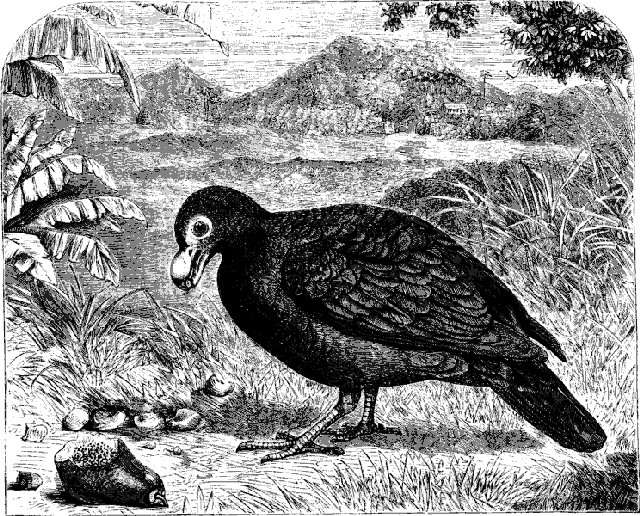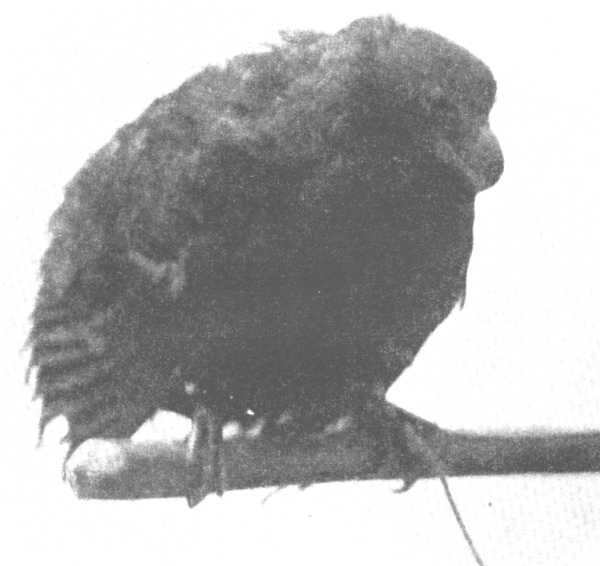
Drawing is from Appleton's Journal
The illustration
shows the general appearance and habit of the bird. It is taken in the act of
feeding upon the fruit of the papaw, of which it is very fond in its
confinement. It has also fed upon cooked taro and bread-fruit. When at liberty it
feeds chiefly upon a species of wild yam.
Text below from Appleton's Journal; January 7, 1871 (pages 27 & 28)
Our illustration this
week is of a rare and curious tooth-billed pigeon recently sent to London from
the Samoan, Navigator's Islands, in the Pacific Ocean, by the missionary, the
Rev. S. J. Whitmee. This bird is a near approximation to the famous dodo. It
received its generic name of didunculus (little dodo) from its resemblance to
the now extinct bird. It has only been found in the Samoan Islands, and will
itself before long become extinct. It is now so scarce that the greatest
difficulty is experienced in securing a specimen. Few of the natives of the
islands have ever seen the bird. Here and there an old man may be found who
remembers the time when it was easily procured in the bush, and greatly esteemed
as an article of food for the highest chiefs. Those familiar with tales of Samoa
in the olden times, say that it was once owned as private property, and
"preserved" as game is in England at the present day. But this was
before the introduction of the fowl into the group. Within a comparatively
recent period a traveling-party belonging to the dominant tribe, or clan, on
arriving at a village of a subject tribe where they intended to spend the day,
would order the chief man of the village to procure them a certain number of
didunculus before night. If they failed to provide the birds, a severe cudgeling
would be the consequence; a punishment which etiquette (or fear)
required them meekly to bear.
The didunculus roosts on
low stumps or roots of trees, and thus readily falls a victim to the wild-cats,
which have become numerous in the Samoan Islands, although the cats has been
comparatively recently introduced. During the past seven years only six
specimens, we believe, have been secured; and these only after patient waiting
and watching in the places the bird is known to frequent. It is generally taken
when very young, before it becomes strong on the wing; or during the period of
incubation, when, in consequence of the closeness with which the birds sit upon
the nest, the natives sometimes secure them. The duty of incubation is performed
alternately by both male and female.
The native name of the
didunculus is Manu-mea. Manu is the generic name for an animal, especially a bird; mea indicates the
color, meaning yellowish brown, as
sear leaves. The bird is about twelve inches in length, including the head and
the tail; and about the same from tip to tip of extended wings. It has the head
of a rapacious bird on the body of a pigeon. In the form of the bill, and
several other respects, it differs from all other known species. The upper
mandible is convex and strongly hooked at the point. The lower mandible is
truncated, and fits into the curve of the upper one; it has also three
well-defined teeth of on either side of it. There is membrane in the sides of
the upper mandible, in which are placed the elongated nostrils. The bird is
powerful on the wing, and flies with a peculiar whirr, resembling the noise made
by a pheasant rising in cover more than anything we know. This gives rise to a
Samoan phrase, "As noisy as a manu-mea." It has also a remarkable
manner of walking with a heavy thumping sound. It runs very rapidly. In the
adult condition the back, upper portion of the wings, and tail, are
chocolate-red, exceedingly glossy and beautiful; the head, neck and breast are
olive or greenish black; the legs and feet bright scarlet; the beak is orange,
tipped with yellowish white; claws yellowish white. There is a bright-orange
circle around the eyes, the iris of which is dark.
The male bird has a very
savage look, and his conduct toward other birds in confinement with him is in
keeping with his appearance. The specimen from which our illustration was taken
was extremely spiteful to all other inmates of the aviary, except some small
birds which seemed to be beneath his notice. On the introduction of the a
arrival, it invariably had to endure the most implacable persecution from the
lord of the aviary. At the end of the week the poor new-comer presented an
almost pitiable figure, the result of the drubbing it had endured. This was the
"footing" which all had to pay, after which matters went on peaceably so long as the underlings did not forget their subject condition. Yet our
didunculus was a very shy bird, and never would become tame, even with those
constantly feeding it. When approached it would run into a corner, or flutter
about in fright. It never attempted to bite when taken in the hand. At
feeding-time it would sit at a safe distance eyeing the food, the body quivering
with a singular vibration from head to tail. This appeared to be rage at seeing
the tamer birds come near to the person feeding them, and taking first share of
the food. The same vibration of body is often noticed when it is approached; it
is probably produced both by fear and rage. As soon as the person feeding them
had retired, he would fly to the food, driving the other birds pell-mell, and
eat in solitary dignity till he had satisfied himself.

Photograph of actual bird by Dr. Augustin Kramer in 1901

Tooth-billed Page

